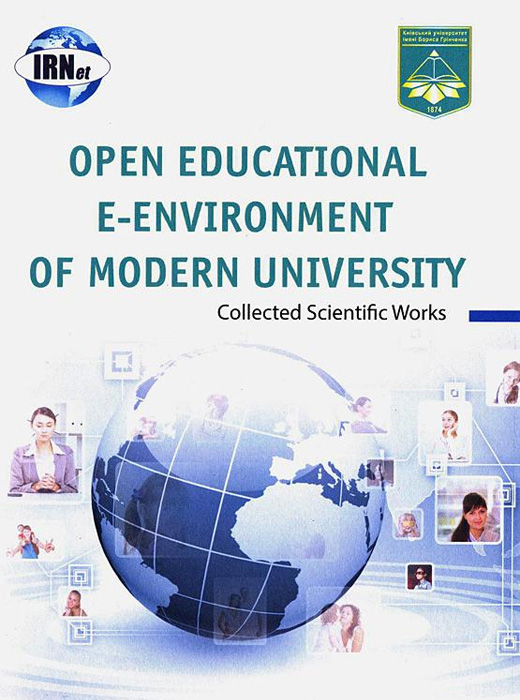HOW TO BE A TEACHER IN THE 21ST CENTURY
DOI:
https://doi.org/10.28925/2414-0325.2015.1.201t06Ключові слова:
teaching, new technologies, e-learning, b-learning, soft skillsАнотація
The article examines the role of a teacher in the “school of future”. It emphasizes that technological revolution has caused enormous changes in new methodologies and didactic tools implementation. The author examines the stages of e-learning, highlights the main aspects of teacher’s mission in the 21st century and offers the core skills that teachers should acquire to be successful in teaching.
Завантаження
Посилання
Ballantyne, D. (2000). Subject: None Discussion forum: OtiS — Tutor Roles. http://vls.scotcit.ac.uk/
Blom, D. (2000). The students educational experiences. Discussion forum: OTiS — Best Practice for Effective Tutoring (9). http://vls.scotcit.ac.uk/
Bloom, B. S., Krathwohl, D. R., Furst, E. J., Engelhart, M. D., Hill, W. H. (1989). Taxonomy of Educational Objectives, Book 1: Cognitive Domain. New York: Longman Publishing.
Briner, M. (1999). Behaviorism. http://curriculum.calstatela.edu/faculty/psparks/theorists/501behav.htm
Briner, M. (1999). Constructivism. Theory Jean Piaget. http://curriculum.calstatela.edu/ faculty/psparks/theorists/501const.htlm
Briner, M. (1999). Theory Lev Vygotsky. http://curriculum.calstatela.edu/faculty/psparks/theorists/501vygot.htm
Cambridge IITT. (2000). Competencies for Online Tutors. http://www.iitt.org.uk/c
onltutor.htm
Chaloupka, M., Koppi, T. (1998). A Vignette Model for Distributed Teaching and Learning. Association for Learning Technology Journal (ALTJ). UK: University,Wales.
Christine, B., Barbara, S., (2001). Interaction, Assessment and Collaboration in Online Courses.
http://www.peakpeak.com/~barbs/biblio.html
Clarkson B. and Brook C. (2004). I can’t Understand Why I didn’t Pass: Scaffolding Student Activities.
Collis, B. (1998). Does More Technology Mean More Choice for the Learner? Experiences from the TeleScopia Project. Vocational Training, No.7. http://www.firn.edu/~face/about/dec95/mult_int.html
Cornelius, S., Higgison, C. (2001). The Tutor’s Role. http://otis.scotcit.ac.uk/onlinebook/otis
t2.htm
Downes, S. (2005). E
Learning 2.0. http://www.downes.ca/post/31741
Downes, S. (2007). E
Learning 2.0 in Development. http://www.slideshare.net/Downes/elearning
in
development
Downes, S. (2007). Free Learning and Control Learning. http://www.downes.ca/
Downes, S. (2007). Web 3.0 and Learning. http://www.downes.ca/cgi
bin/page.cgi?post=36700
Dunkin, R. (2000). The Institutional Support Perspective. Keynote presentation to OtiS workshop “Developing online tutors”.
http://itlearningspace
scot.ac.uk/courses/keynotes/module5/main.cfm
Frank C., David M., Elaine H., Kathryn E. (2004). Learning Styles and Pedagogy in post
learning: A Systematic and Critical Review. Learning and Skills Research Centre.
Gagné, R. M. (1985). The Conditions of Learning. 4’ ed. New York: Holt, Rinehart and Winston.
Gagne, R. M., Briggs, L. J. & Wagner, W. W. (1992). Principles of Instructional Design (4th ed.), Holt, Reihhart, and Winston Inc.
Siemens, G. (2005). Connectivism: A Learning Theory for the Digital Age. http://www.elearnspace.org/Articles/connectivism.htm
Goldman S. (2000). Internet: e
Learníng. Goldman Sachs Global Equity Research.
Higgison, C. (2000). Subject: Determining Learning Styles. Discussion Room: OTiS — Tutor and Learner Styles (4). http://vls.scotcit.ac.uk/
Hird, A. (2000, 10 July). Subject: Pedagogy and Roles Discussion Room: OTiS — Tutor Roles (2). http://vls.scotcit.ac.uk/
IITT (2000). Competence Frameworks — Online Tutors, Competencies for Online Tutors.
onltutor.htm
Janes, D. (2000). Discussion Room: OTiS — Models of Online Learning and Tutoring (8). http://vls.scotcit.ac.uk/
O’Reilly, Tim. (2005). What Is Web 2.0. Design Patterns and Business Models for the Next Generation of Software.
http://www.oreillynet.com/pub/a/oreilly/tim/news/2005/09/30/what-is-web-20.html













1.jpg)








